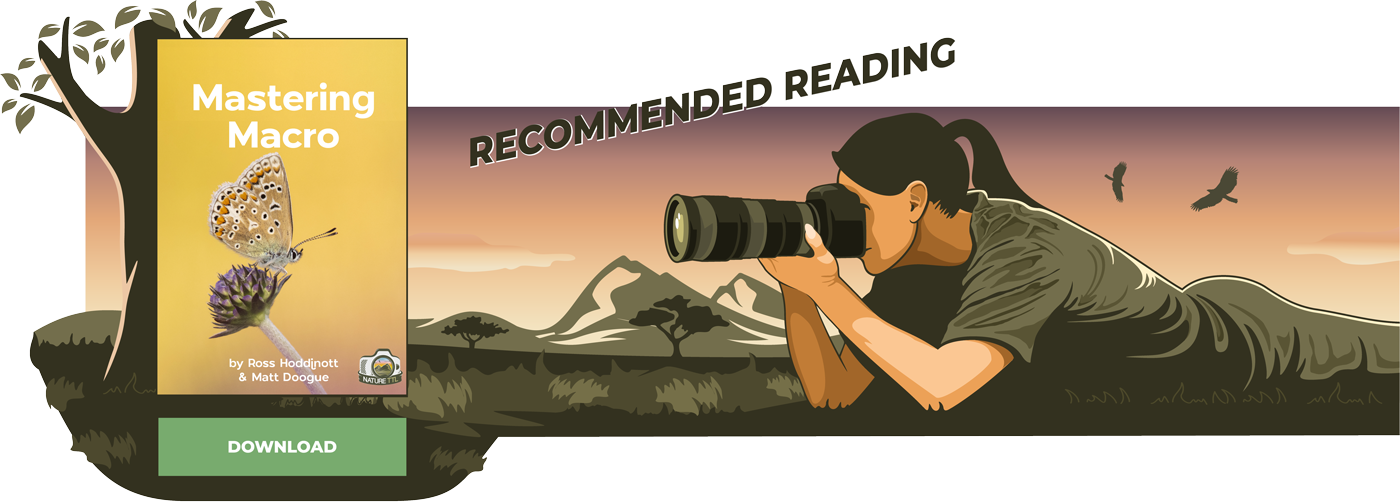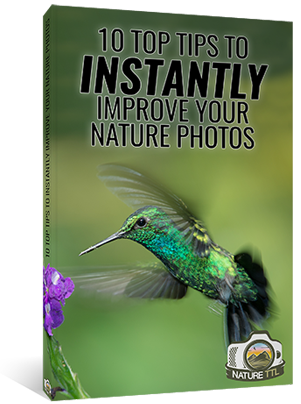Macro Wildlife Photography: Top Tips for Overlooked Subjects

Macro wildlife photography is one of the most exciting and rewarding disciplines in the photographic hobby. By choosing to focus on smaller macro subjects, you get to discover details often overlooked.
You can also produce truly captivating imagery of subjects many people rarely get to see.



Many macro photographers tend to focus on insects and flowers. These two subjects tick all the right boxes in terms of rarely seen, yet eye-catching visuals.
From character-filled jumping spiders to masterpiece-worthy flower petals, bugs and plants often take the limelight in this photography discipline.
However, in this article, we’ll encourage you to look beyond the most popular and conventional macro subjects to alternatives that are closer than you think.
From reptiles and amphibians to mammals and fungi, we’ll look at the gear and know-how you’ll need to get into macro wildlife photography and capture these subject-worthy alternatives.
Read more: Introduction to Macro Photography – Technique
Beyond bugs: overlooked macro subjects
The great thing about macro wildlife photography is that photo-worthy subjects are everywhere – if you know where to look. As we’ve already mentioned, insects and flowers are ideal go-tos, but the macro subject library doesn’t end there.
Whether it’s a see-through frog or a bird feather close-up, there are nearly endless wildlife opportunities to shoot.
Why not consider one of these often-neglected subjects next time you’re in the mood for macro?
Reptiles and amphibians
Snakes, lizards, and other scaled animals are just asking for a macro-level investigation.

These cold-blooded creatures are covered in textures and patterns. They can even appear rainbow-reflective, making them an ideal subject for close-up photography.
Read more: How to Photograph Reptiles and Amphibians with Flash
Birds
While the majority of opportunities to photograph birds undoubtedly come from a distance, macro situations can, on occasion, present themselves. Body elements, such as feathers, talons, and beaks, are all often overlooked, yet offer unique views.
Read more: How to Use Negative Space in Macro Photography
Mammals
Similarly to birds, the chance to photograph mammalian subjects is often fleeting, which can limit potential opportunities.
However, with the right luck and know-how, mammalian macro photography is definitely possible. Fur, whiskers, eyes, and various reflective surfaces offer plenty of possibilities.
Marine life
With the right underwater setup, a whole new world of potential macro subjects opens up.
Marine life, including fish, nudibranchs, and crustaceans, comes in every color and often possesses unique features that are rarely captured on film, both because of their size and underwater location.
Read more: Top Tips to Improve Your Underwater Macro Images
Fungi
Perhaps one of the most overlooked subjects is also one of the easiest to find — seeing as it doesn’t move. Fungi usually boast numerous unique surfaces and textures, which, when captured using a macro lens, make for abstract and exciting imagery.
Ultimately, whether you’re in the rainforest, the desert, or even just in your backyard, a worthy macro wildlife photography subject is never far away.
Read more: How to Photograph Woodlands – Trees, Streams, and Fungi
Gear for macro wildlife photography
Successful macro wildlife photography requires the right gear for the job.

Alongside a lens capable of making smaller subjects appear larger, you’ll often need additional lighting. Here is an overview of the basic pieces of kit you’ll want for photographing small to mid-sized macro subjects.
Read more: Introduction to Macro Photography – Equipment
Macro-capable lens
To capture frame-filling macro close-ups, you’re going to need a lens with macro capability. The best macro photography lens for you may depend on many factors, including your budget, choice of subject, and its practicality in the field.
For those new to the hobby, extension tubes or a close-up filter can offer a budget-friendly alternative to buying a new lens.
Read more: What’s the Best Macro Photography Lens?
Lighting
The right lighting is just as, if not more, important than a lens when it comes to taking macro photos.

To achieve stand-out images, you’ll want to combine a light source, usually a flash, with a diffuser.
Read more: Backlighting in Macro Photography
Flash
It is possible to produce high-quality macro images using a built-in camera flash. However, using a built-in flash does limit your ability to move or direct the light yourself. Ideally, you need an off-camera flash or ring lights.
Read more: How to Balance Flash with Ambient Light in Macro Photography
Diffuser
The right diffuser can be the difference between a good and a great photo. A photographer’s choice of diffuser will often come down to a personal preference.
However, if you’re just starting out, this foldable diffuser is great for an in-built or body-mounted flash, and this softbox is an ideal place to start for off-camera flashes.
With a macro lens on your camera and a flash alongside, you’re ready to capture some great macro images.
Techniques for small-subject macro wildlife photography
There are several important techniques that come together to produce successful macro wildlife photography.

Here’s an overview of some of the key elements to think about.
How to stabilize your camera
In some cases, insect and flower macro photography can allow for – and be bettered by – the use of a tripod. However, small-subject macro wildlife photography doesn’t require a tripod, as it requires you to be more mobile.
Generally, holding your camera body with two hands and mounting the flash to the body is a great place to start. If you’re pursuing ground-dwelling subjects, consider using a beanbag or towel under your camera body as a more versatile answer to stabilizing your rig.
Read more: Macro Photography – How to Take Handheld Photos of Insects
Lighting
It’s a great idea to begin with your flash mounted to your camera body. Once you’ve got a feel for what that angle produces, you may want to explore alternatives by taking the flash off the body and playing around with lighting your subjects from the top, the side, or even the back.

Switching the angle from which the flash is fired can create images with more emotion, such as eye-catching, low-key-style photos.
Where to focus and choice of aperture
Your chosen focusing mode will depend a lot on you. If your camera has an AI focus, you may prefer to opt for this. Alternatively, if you want a little more control of the focus, you can switch to a ‘one shot’ option.
Lastly, if you really want complete control, switch to manual focusing. In general, focus on the key detail of the image you want, usually something like an eye (most common), a feather, or a scale.
In terms of aperture, a great place to start for small-subject macro shots is f/11. You can experiment from there if you don’t love the results at f/11.
Always shoot in RAW
Shooting in RAW is a good standard practice. It’s that simple. This is especially true if you intend to edit your images. In the field, the window when a subject appears may be quite short.

Shooting in RAW will allow you to comprehensively adjust or correct more elements in post processing, allowing you to correct anything you missed during especially fleeting wildlife encounters.
Read more: Don’t Delete Your Raw Files for DNG Format
Be patient
The last technique for macro wildlife photography is less to do with the technical side of photography and more to do with the mental side.
Patience is very much a virtue in this hobby. Mistakes will be made and being able to clear your mind, swallow any frustration and calmly refocus will help you achieve better results in the end.

By putting all of these techniques together, you should be able to produce high-quality macro images. It’s also a good idea to practice and hone your macro photography technique at home using models before you head out into the field.
This practice will also let you get a feel for the style of imagery you prefer.
Ethical considerations
When photographing wildlife, it’s always important to remember that the welfare of the plant or animal should be your top priority. No photo is worth causing harm to an animal.
Here are some key ethical considerations when photographing wildlife, especially when photographing animals in a macro capacity.
Minimize disturbance – The best photographers are capable of achieving outstanding imagery without disturbing the animal in front of them. As mentioned above, honing your skills at home in a controlled environment can ensure you are quick and efficient in the field.
Know the animal in front of you – Whether it’s protected, venomous, poisonous or particularly susceptible to human contact, it’s always a smart idea to enter the field with knowledge about the animals you may find.

Always check out local field guides or wildlife blogs before you step outside.
Choosing to put the animal first sets a good example for fellow photographers and helps to ensure the animals we enjoy seeing are likely to be around for years to come.
In conclusion
It’s easy to see why macro photography is so popular on social media and especially with photography hobbyists. The ability to capture these often overlooked subjects at a level that reveals their hidden qualities is unique.
Not only will the people who see your photographs start to interpret the world in a whole new light, but you will also start to notice the smaller side of wildlife after beginning your journey into macro wildlife photography.
Whether it’s a butterfly’s wing, a snake’s scales or a monkey’s human-like hands, macro investigation is rarely a dull experience.
If you’re excited to see what you can reveal under your macro lens, get out there and discover the macro world for yourself.





